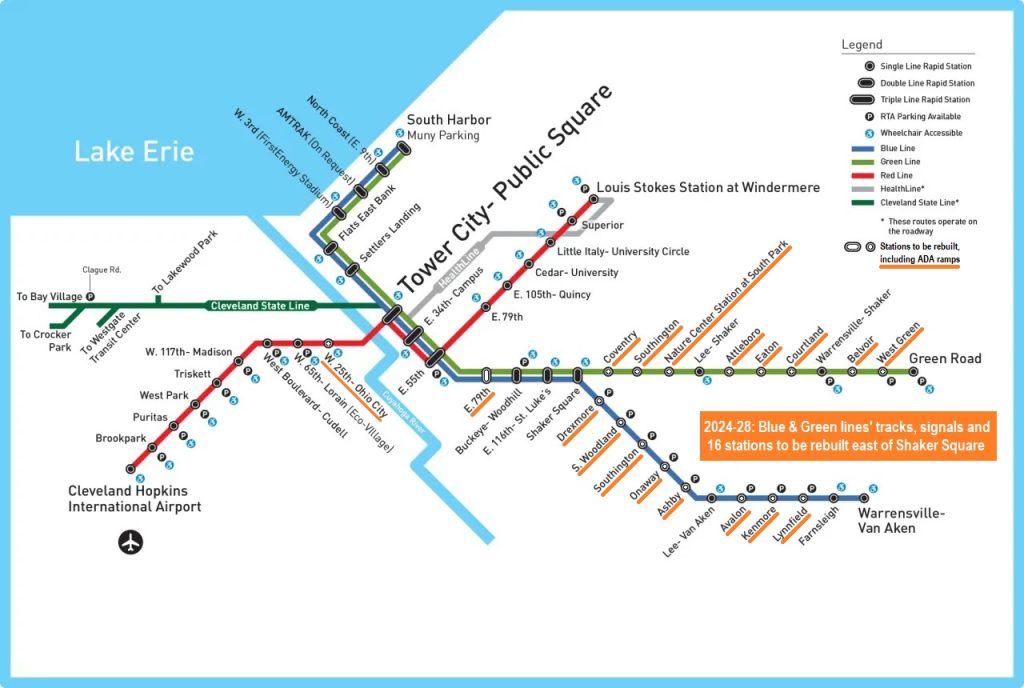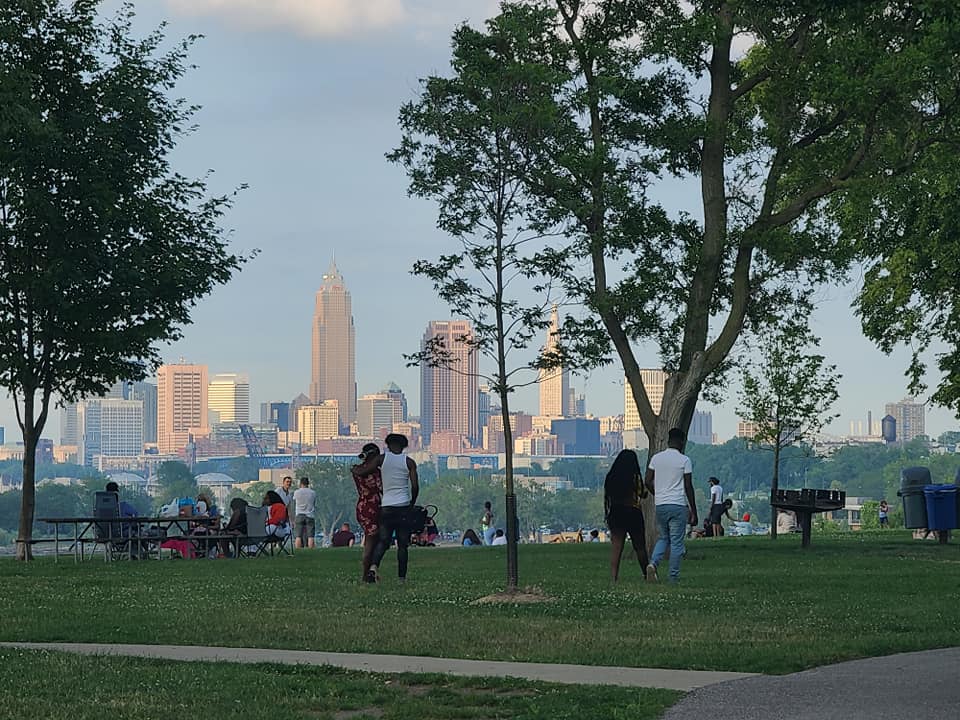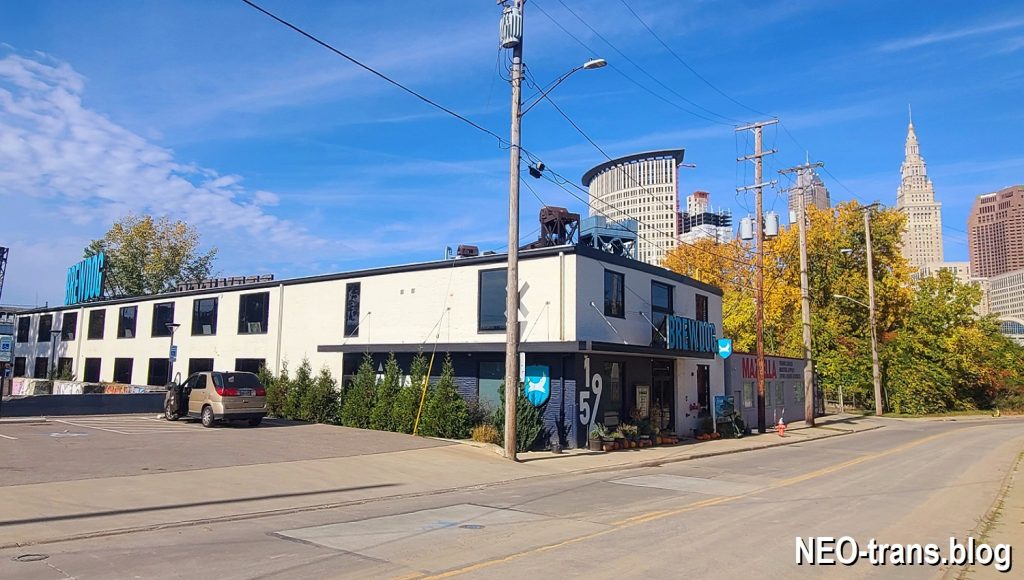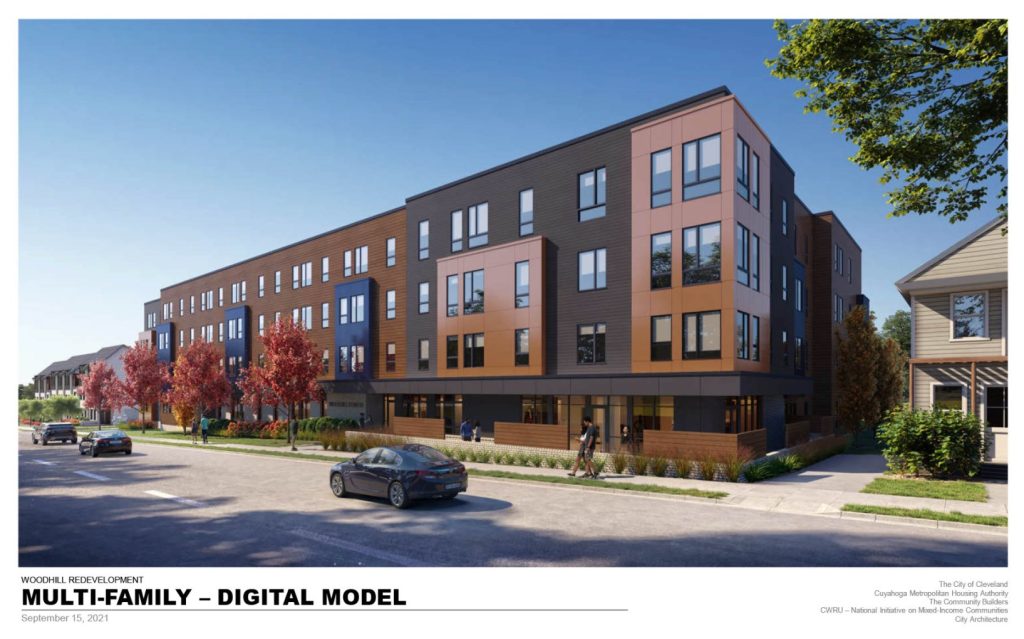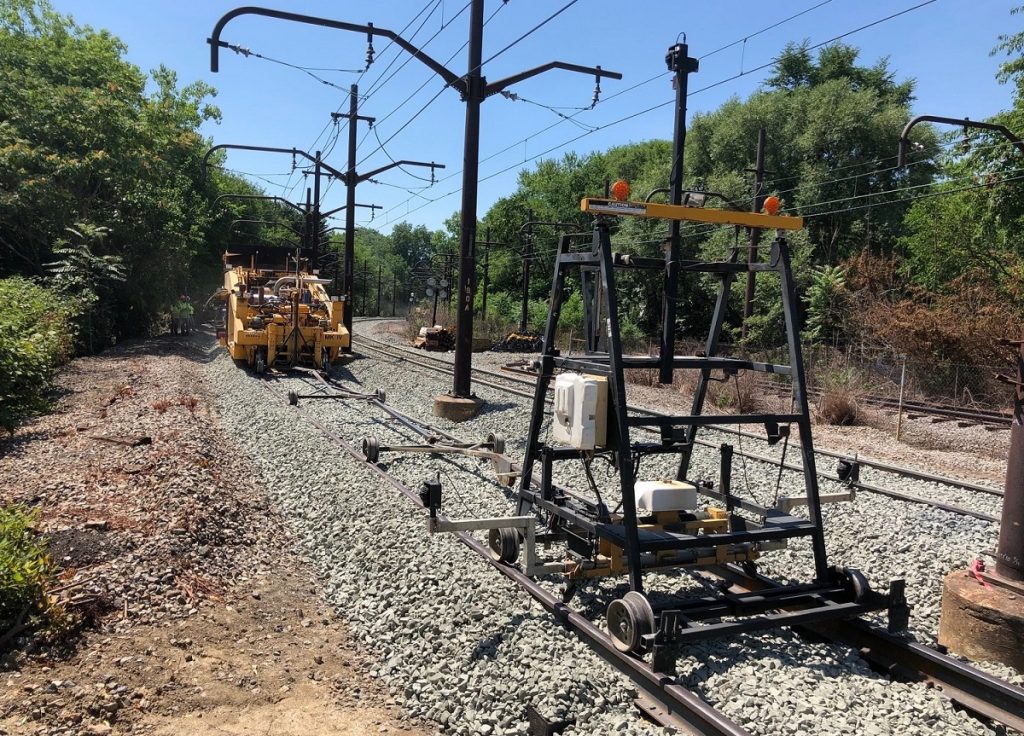
The combined section of the Blue/Green lines west of Shaker Square called the Trunk Line was completely rebuilt from the ground up in 2020. Over five years starting in 2024, reconstruction work will turn to the branches of the Blue and Green lines east of Shaker Square. That is projected to cost $115.6 million for renewed infrastructure and $92.6 million for new trains or $208.2 million total (GCRTA). CLICK IMAGES TO ENLARGE THEM.
Work is part of GCRTA’s $686.8 million capital budget
Starting next year and continuing until 2028, the Greater Cleveland Regional Transit Authority (GCRTA) plans to completely rebuild its two rail rapid transit lines in Shaker Heights, east of Cleveland’s Shaker Square. Called the Blue and Green lines, this would be their first major infrastructure rebuilding since 1980. But not everyone is on board with this $208.2 million initiative that is included in GCRTA’s proposed capital budget, scheduled to get a public hearing May 2.
The transit authority’s proposed $686.8 million, four-year capital budget would be its largest except for its current four-year budget which includes $183 million of the funding for GCRTA’s $393 million rail car replacement program. The proposed capital budget, which pays for physical improvements to Cuyahoga County’s transit system, includes an ongoing program of bus replacements, major repairs or equipment replacements at facilities like bus garages, electrical substations and bridges.
It also includes new services like the MetroHealth Bus Rapid Transit (BRT) which is programmed at $48.5 million in 2024-26, with most of the spending set for 2025-26. However, the capital budget is short $25 million for this project which would rebuild West 25th Street from Detroit Avenue south to near the Cleveland Metroparks Zoo with a streetscape, improved transit waiting environments and faster transit trip times. GCRTA officials said they hope the as-yet unrealized funding will come from a mix of local, state and federal funds.
Along the Airport-Windermere Red Line, which is due to receive GCRTA’s first new trains in 2026, two major capital improvements are planned. One is the rehabilitation of Red Line-east track, east of East 55th, costing about $19.5 million. It is programmed for 2028 and is fully funded — assuming there are no federal budget cuts. Also, an $11.2 million reconstruction of the Ohio City-West 25th Red Line station is set for 2027. GCRTA rebuilt all 18 of the Red Line stations since 1990 so they are handicapped accessible. The Ohio City station was the first to be reconstructed along Cleveland’s 34-mile rail system dubbed “The Rapid.”
But GCRTA’s biggest capital improvement project along the 15-mile Blue/Green lines, which connect downtown’s Waterfront with Shaker Heights, is actually made up of smaller projects, each one being significant on its own. When combined, the reconstruction of the light-rail Blue/Green line branches (Blue Line runs in the media of Van Aken Boulevard and the Green Line runs in the median of Shaker Boulevard) east of Shaker Square amount to $115.63 million for infrastructure improvements and $92.59 million for new trains for a total of $208.2 million. The significant projects along the Blue/Green lines are as follows:
- In 2024-26, GCRTA intends to rebuild tracks on the Blue/Green light-rail branches east of Shaker Square from the subgrade up. It is almost fully funded at $46.5 million. But $28.5 million is not yet available. Work includes drainage work, new ballast (the gravel in which tracks are set), replacing rails weighing 100 pounds per yard with 115-pound rails and heavier-duty crossties. That will result in a smoother, faster ride.
- Light-rail signal systems will be upgraded from 2024-28, including the addition of fiber optic cables, on both the Green and Blue lines east of Shaker Square as well and totaling $23.58 million. This is fully funded.
- The remaining 16 light-rail stations in Shaker Heights that aren’t ADA accessible will be rebuilt with new platforms including handicapped ramps. None of the funding is in place to rebuild all eight remaining Blue Line stations costing $16 million in 2025 and eight Green Line stations in 2027, also for $16 million, or $32 million total.
- Replacement of the East 79th Blue/Green Line station in Cleveland’s Kinsman neighborhood and costing about $11.75 is programmed for 2024 and is fully funded. This follows the 2021 reconstruction of the East 79th Red Line station.
- Reconstruction of a retaining wall along the Blue Line near Lee Road estimated at $1.8 million and has funding identified.
- Replacement of four-decade-old light-rail vehicles on the Blue/Green lines is budgeted at $92,587,500 for 2024-28 but most of the funding is not yet secured.
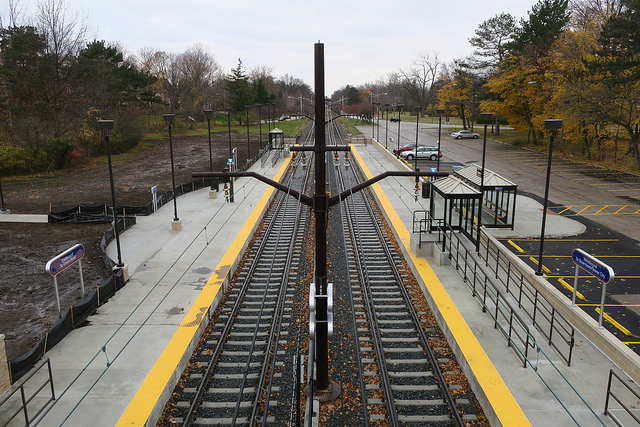
The Greater Cleveland Regional Transit Authority’s Warrensville-Shaker station on the Green Line after its rebuilding in 2016. The transit authority plans to spend $32 million to rebuild 16 stations on the Blue and Green lines in Shaker Heights so they are in a state of good repair and are handicap-accessible. After that work, all rail stations in Shaker Heights will be ADA-accessible (GCRTA).
“This work will allow GCRTA to increase the track speeds from 35 mph back to 45 mph and increase our peak hour trains from nine to 12 cars when our new rail vehicles arrive,” said GCRTA staff in a project summary. “Completion of this project will provide our customers with safer, faster, smoother and more reliable rail service in this area.”
Currently, because of a shortage of working trains, both the Blue Line and the Green Line run every 30 minutes regardless of whether it’s during peak rush hours and off peak. That would improve to every 20 minutes during rush hours with the new trains. On the shared Blue/Green “Trunk Line” west of Shaker Square, the schedule currently has a train departing every 15 minutes in both directions.
“A huge piece of the strategic plan is to replace our rail cars and bring our entire rail system up to a state of good repair, which includes investing in the light-rail system,” said GCRTA’s Public Information Officer Robert Fleig. “This is reflected in our five-year capital improvement program. There are a number of cities across the nation spending billions to build what GCRTA already has in place. It’s a wise investment for GCRTA to maintain and bring to a state of good repair such a valuable asset.”
The rebuild east of Shaker Square follows major infrastructure improvements on the Trunk Line from Shaker Square west to near East 55th Street where the Blue/Green lines join the Red Line for the path into downtown Cleveland. GCRTA invested $50.3 million into rebuilt stations, renewed tracks and modernized signal systems along this section in the last decade. Six stations east of Shaker Square have also been rebuilt including with handicapped access — Lee-Shaker, Lee-Van Aken, Farnsleigh, Warrensville-Shaker, Warrensville-Van Aken, and Green Road.
While the Warrensville-Van Aken station at the east end of the Blue Line was upgraded with handicapped access two decades ago, it is in need of a facelift and redesign to better serve the growing Van Aken District development. That transit-oriented development has two high-rise towers under construction with a third large building planned on the former Qua Buick site. Starting later this year, a $6 million project will begin to relocate the Blue Line tracks and build a new bus and rail station with a climate-protected building with restrooms. It isn’t counted in the 2024-28 capital budget.
“This is a huge step forward by the GCRTA to not only rebuild the Rapid, but to restore confidence in the entire system,” said Stu Nicholson, executive director of All Aboard Ohio, a nonprofit association that advocates for improvements to passenger rail and public transit. “After decades of administrative neglect and failure to keep the Rapid and its infrastructure in good working order, this new budget is an encouraging sign. All Aboard Ohio applauds GCRTA.”

Some stations along the Blue and Green lines are falling apart since they were last rebuilt 43 years ago. The East 79th Street light-rail station is among those scheduled to get rebuilt in the next few years, although with new tracks, signals and overhead electrical power supply to the trains (KJP).
But not everyone in the rail and transit community was on board with the idea of investing so much money on light-rail lines whose ridership ranks 35th out of 44 light-rail public transportation services in North America. The rail lines also converge on downtown Cleveland whose employment has fallen while University Circle’s has risen to the point where it may exceed downtown’s in the next five to 10 years.
“As a Shaker Heights resident, I am thankful GCRTA is contemplating investing $200 million in the rebuilding and re-equipping of the historic former Shaker Heights Rapid Transit light-rail lines,” said Ken Sislak, a former director of GCRTA’s rail division in the 1980s. “This is a fraction of the cost of planning, designing and constructing these light-rail lines if it was to be done today. However, with combined ridership lower than an average bus line, one needs to examine the cost effectiveness of spending that much money on an asset with diminishing utility. Has GCRTA considered alternatives to this?”
Nearly 30 years ago, as part of the Dual Hub Corridor program (12.6MB PDF) that created the HealthLine bus rapid transit, GCRTA proposed rerouting one or both of the Blue and Green lines to University Circle. They would travel 1.5 miles north from Shaker Boulevard and East 116th, down Fairhill Boulevard and into University Circle, costing $73.6 million to build (or more than $150 million today). Instead, for $70.9 million in 1996, GCRTA extended the Blue/Green lines 2 miles to downtown’s lakefront as the Waterfront Line. After the first few years of promising ridership with fares discounted 50 percent, the full fare was added and ridership never recovered.
A decade ago, GCRTA recommended the University Circle Express bus service (4.3MB PDF), originating at new park-and-ride stations at Northfield Road and Interstate 480 in North Randall at Harvard Road and Interstate 271 in Chagrin Highlands. The bus routes were proposed to meet at the Van Aken-Warrensville Blue Line Station and run on Van Aken Boulevard to loop around University Circle before heading back east. The buses would parallel the Blue Line rail service but stop only at the Van Aken-Warrensville and Shaker Square rail stations, in addition to stops in University Circle and south/east of Van Aken-Warrensville. GCRTA never followed through on the plan. Today, the No. 48 bus provides 24-hour connections between Shaker Square, University Circle and Cleveland Clinic.
Sislak suggested a similar concept except replacing the Blue/Green line trains east of Shaker Square with buses, which would meet trains to downtown and the airport at Shaker Square. When GCRTA acquires its new standardized railcars and rebuilds Red Line stations to accommodate them, the transit authority is proposing running trains from Shaker Heights through downtown to Hopkins International Airport as well as to the Waterfront Line which will restart in August after a two-year hiatus and a $6 million bridge repair project. At its last board meeting, GCRTA also approved $1 million to freshen up five Waterfront Line stations prior to the August reboot.
Shaker Heights Mayor David Weiss, also a GCRTA board member, received but did not respond to an e-mail inquiry from NEOtrans prior to publication of this article.
END

